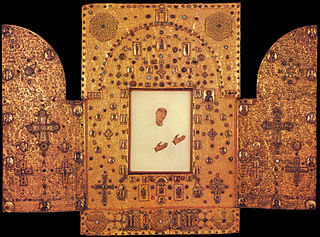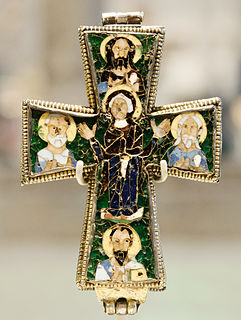
Walrus ivory, also known as morse, comes from two modified upper canines of a walrus. The tusks grow throughout the life and the tusks of a Pacific walrus may attain a length of one meter. Walrus teeth are also commercially carved and traded; the average walrus tooth has a rounded, irregular peg shape and is approximately 5 cm in length.

The Alfred Jewel is a piece of Anglo-Saxon goldsmithing work made of enamel and quartz enclosed in gold. It was discovered in 1693, in North Petherton, Somerset, England and is now one of the most popular exhibits at the Ashmolean Museum in Oxford. It has been dated to the late 9th century, in the reign of Alfred the Great, and is inscribed "AELFRED MEC HEHT GEWYRCAN", meaning "Alfred ordered me made". The jewel was once attached to a rod, probably of wood, at its base. After decades of scholarly discussion, it is now "generally accepted" that the jewel's function was to be the handle for a pointer stick for following words when reading a book. It is an exceptional and unusual example of Anglo-Saxon jewellery.

Cloisonné is an ancient technique for decorating metalwork objects with colored material held in place or separated by metal strips or wire, normally of gold. In recent centuries, vitreous enamel has been used, but inlays of cut gemstones, glass and other materials were also used during older periods; indeed cloisonné enamel very probably began as an easier imitation of cloisonné work using gems. The resulting objects can also be called cloisonné. The decoration is formed by first adding compartments to the metal object by soldering or affixing silver or gold as wires or thin strips placed on their edges. These remain visible in the finished piece, separating the different compartments of the enamel or inlays, which are often of several colors. Cloisonné enamel objects are worked on with enamel powder made into a paste, which then needs to be fired in a kiln. If gemstones or colored glass are used, the pieces need to be cut or ground into the shape of each cloison.

Filigree is a form of intricate metalwork used in jewellery and other small forms of metalwork.

Anglo-Saxon art covers art produced within the Anglo-Saxon period of English history, beginning with the Migration period style that the Anglo-Saxons brought with them from the continent in the 5th century, and ending in 1066 with the Norman Conquest of England, whose sophisticated art was influential in much of northern Europe. The two periods of outstanding achievement were the 7th and 8th centuries, with the metalwork and jewellery from Sutton Hoo and a series of magnificent illuminated manuscripts, and the final period after about 950, when there was a revival of English culture after the end of the Viking invasions. By the time of the Conquest the move to the Romanesque style is nearly complete. The important artistic centres, in so far as these can be established, were concentrated in the extremities of England, in Northumbria, especially in the early period, and Wessex and Kent near the south coast.

The Stavelot Triptych is a medieval reliquary and portable altar in gold and enamel intended to protect, honor and display pieces of the True Cross. Created by Mosan artists—"Mosan" signifies the valley of the Meuse river—around 1156 at Stavelot Abbey in present-day Belgium. The work is a masterpiece of Romanesque goldsmith's work and is today in the Morgan Library & Museum in New York City.

What is usually referred to as St Cuthbert's coffin is a fragmentary oak coffin in Durham Cathedral, pieced together in the 20th century, which between AD 698 and 1827 contained the remains of Saint Cuthbert, who died in 687. In fact when Cuthbert's remains were yet again reburied in 1827 in a new coffin, some 6,000 pieces of up to four previous layers of coffin were left in the burial, and then finally removed in 1899. This coffin is thought to be Cuthbert's first wooden coffin, and probably to date to 698, when his remains were moved from a stone sarcophagus in the abbey church at Lindisfarne to the main altar.

The Brussels Cross or Drahmal Cross is an Anglo-Saxon cross-reliquary of the early 11th century, now in the treasury of the St. Michael and St. Gudula Cathedral, Brussels, that bears engraved images and an inscription in Old English.

The Khakhuli triptych is a partially preserved large repoussé triptych icon of the Theotokos created in medieval Georgia. It incorporates over 100 specimens of Georgian and Byzantine cloisonné enamel dated from the 8th to the 12th century. The icon is now on display at Art Museum of Georgia in Tbilisi.

The Easby Cross is an Anglo-Saxon sandstone standing cross from 800–820, now in the Victoria and Albert Museum, London. It originally came from Easby near Richmond in the Richmondshire district of North Yorkshire, where a plaster replica is kept in the church. Easby was then in the Kingdom of Northumbria. The width of the long faces at the bottom of the lowest fragment is 31 cm (12 in), with a depth of 18 cm (7.1 in), and the whole cross would originally have been up to 3 metres (9.8 ft) high.

The Holy Thorn Reliquary was probably created in the 1390s in Paris for John, Duke of Berry, to house a relic of the Crown of Thorns. The reliquary was bequeathed to the British Museum in 1898 by Ferdinand de Rothschild as part of the Waddesdon Bequest. It is one of a small number of major goldsmiths' works or joyaux that survive from the extravagant world of the courts of the Valois royal family around 1400. It is made of gold, lavishly decorated with jewels and pearls, and uses the technique of enamelling en ronde bosse, or "in the round", which had been recently developed when the reliquary was made, to create a total of 28 three-dimensional figures, mostly in white enamel.

The Lindau Gospels is an illuminated manuscript in the Morgan Library in New York, which is important for its illuminated text, but still more so for its treasure binding, or metalwork covers, which are of different periods. The oldest element of the book is what is now the back cover, which was probably produced in the later 8th century in modern Austria, but in the context of missionary settlements from Britain or Ireland, as the style is that of the Insular art of the British Isles. The upper cover is late Carolingian work of about 880, and the text of the gospel book itself was written and decorated at the Abbey of Saint Gall around the same time, or slightly later.

The Middle Ages was a period that spanned approximately 1000 years and is normally restricted to Europe and the Byzantine Empire. The material remains we have from that time, including jewelry, can vary greatly depending on the place and time of their creation, especially as Christianity discouraged the burial of jewellery as grave goods, except for royalty and important clerics, who were often buried in their best clothes and wearing jewels. The main material used for jewellery design in antiquity and leading into the Middle Ages was gold. Many different techniques were used to create working surfaces and add decoration to those surfaces to produce the jewellery, including soldering, plating and gilding, repoussé, chasing, inlay, enamelling, filigree and granulation, stamping, striking and casting. Major stylistic phases include barbarian, Byzantine, Carolingian and Ottonian, Viking, and the Late Middle Ages, when Western European styles became relatively similar.

The Cross of Mathilde is an Ottonian processional cross in the crux gemmata style which has been in Essen in Germany since it was made in the 11th century. It is named after Abbess Mathilde who is depicted as the donor on a cloisonné enamel plaque on the cross's stem. It was made between about 1000, when Mathilde was abbess, and 1058, when Abbess Theophanu died; both were princesses of the Ottonian dynasty. It may have been completed in stages, and the corpus, the body of the crucified Christ, may be a still later replacement. The cross, which is also called the "second cross of Mathilde", forms part of a group along with the Cross of Otto and Mathilde or "first cross of Mathilde" from late in the preceding century, a third cross, sometimes called the Senkschmelz Cross, and the Cross of Theophanu from her period as abbess. All were made for Essen Abbey, now Essen Cathedral, and are kept in Essen Cathedral Treasury, where this cross is inventory number 4.

The craft of cloisonné enameling is a metal and glass-working tradition practiced in the Byzantine Empire from the 6th to the 12th century AD. The Byzantines perfected an intricate form of vitreous enameling, allowing the illustration of small, detailed, iconographic portraits.

The Fieschi Morgan Staurotheke is a small reliquary designed to hold a relic of the true cross, it is 1 1/16 x 4 1/16 x 2 13/16 inches overall with lid. It is an example of Byzantine enameling. The box is dated to 843. Both dates hover around the second wave of Byzantine Iconoclasm from 814 to 842, allowing this piece to become a lens into the post iconoclastic art. These reliquaries doubled as an icon in style and purpose. The physical material of icons and the content within the reliquary were believed to contained a spirit or energy. It was believed that reliquaries contained great power, thus explains its preservation throughout the years. There are numerous theories of where this piece was created and its movement. It's currently on display at the Metropolitan Museum.

The Beresford Hope Cross is a 9th-century Byzantine reliquary cross with cloisonné enameling. It was intended to be worn as a pectoral crucifix, perhaps holding a fragment of the True Cross in the compartment inside. The cross is thought to have been made in southern Italy around the end of Byzantine iconoclasm, between 843 and the mid tenth century. It has been held by the Victoria and Albert Museum since 1886.

The Talisman of Charlemagne is a 9th-century Carolingian reliquary encolpion that may once have belonged to Charlemagne and is purported to contain a fragment of the True Cross. It is the only surviving piece of goldwork which can be connected with Charlemagne himself with some degree of probability, but the connection has been seriously questioned. The talisman is now kept in Rheims in the Palace of Tau.

The Uttoxeter Casket, also known as Philip Nelson's Casket, is an Anglo Saxon reliquary from Uttoxeter, Staffordshire in the United Kingdom. As of 2017, it is held at the Cleveland Museum of Art in Ohio, USA. House-shaped and carved from a single piece of boxwood, it remains the only known surviving wood carving with such an elaborate iconographic programme from this period of British history.

The West Yorkshire Hoard is a precious-metal hoard of six gold objects, including four gold finger-rings, and a lead spindle whorl, which was discovered near Leeds, West Yorkshire, in 2008–2009 by a metal detectorist. The find was of national and international significance, expanding the understanding of hoards and hoarding in the north of England in early medieval England, as well as expanding the corpus of known gold rings from the period.




















